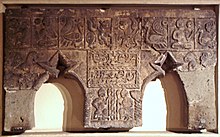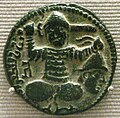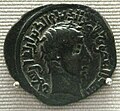Ortoqids
The Islamic dynasty of the Ortoqids or Artukids (also Artuqids ) was an Oghuz ruling house that was divided into three lines from around 1101 to 1409 over the eastern Anatolian region of Diyarbakır with its urban centers Mardin , Maiyafariqin (Silvan) , Amid (Diyarbakır) , Hisn Kaifa (Hasankeyf) and Chartpert (Harput) bid.
history
The dynasty was founded by Artuq ibn Ekseb (or Eksek), a general who was subordinate to the Greater Seljuk Sultan Malik Shah I and later to the Seljuk ruler of Syria , Tutush I , and was appointed governor of Palestine in 1086 . Artuq died in Jerusalem in 1091 , his sons Sökmen (I.) and Il-Ghazi (I.) were driven out by the Fatimid Vesir al-Afdal Shahanshah in 1098, before he himself lost the city to the Crusaders in 1099 .
As a result, Sökmen and Il-Ghazi established their rule in the Jazira , more precisely in Mardin and Hisn Kaifa in Diyar Bakr, where they came into conflict with the Seljuks. Sökmen defeated the Crusaders in 1104 at the Battle of Harran . Il-Ghazi followed him in Mardin, conquered Maiyafariqin and extended his rule to Aleppo in 1118 at the request of Qadis Ibn al-Chashschab . In 1119 he defeated the Crusaders at the Battle of Ager Sanguinis .
Il-Ghazi died in 1122. His successor in Aleppo was nominally his nephew Balak ibn Bahram , but in fact the city was ruled by Ibn al-Chaschschab. He was murdered in 1125, after which Aleppo came under the control of the Zengids of Mosul .
After Balak's death, the Ortoqids split up between Hisn Kaifa and Mardin. Sökken's son Dawud, the lord of Hisn Kaifa and Chartpert, died in 1144. He was followed by his son Qara-Arslan, who allied himself with Joscelin II of Edessa against the Zengids. Zengi conquered Edessa during Joscelin's absence , and then brought Hisn Kaifa under his rule.
Qara-Arslan's son Nur ad-Din Muhammad allied himself with the Ayyubid Saladin against the Sultanate of the Rum Seljuks and its ruler Qilitsch-Arslan II , whose daughter was married to Nur ad-Din Muhammad. Through a peace treaty with Qilitsch-Arslan, Saladin finally gained control of the Ortoqid territory, although the Ortoqids were still vassals of Mosul, which Saladin did not yet rule - with whose help he then brought it into his hands.
Nominally, the Ortoqids continued to rule the Jazira, but their power diminished noticeably under the Ayyubid rule. The dynasty consisted of Hisn Kaifa and Amid from 1102 to 1232, in Mardin from around 1101 to 1409, when the city fell to the Qara-Qoyunlu . The third, subordinate line of Chartpert ruled from 1185 to 1234.
Ruler list
The rulers in Hisn Kaifa and Amid (1102–1232)
- Zahir ad-Daula Artuq ibn Ekseb / Eksek
- Muin ad-Din Sökmen I. ibn Artuq
- Ibrahim ibn Sokmen
- Rukn ad-Daula Dawud ibn Sökmen
- Fachr ad-Din Qara-Arslan ibn Dawud
- Only ad-Din Muhammad ibn Qara-Arslan
- al-Malik al-Masud Qutb ad-Din Sökmen II. ibn Muhammad
- al-Malik as-Salih Nasir al-Din Mahmud ibn Muhammad
- al-Malik al-Masud Rukn ad-Din Maudud ibn Mahmud
The rulers in Chartpert (1185–1234)
- Imad ad-Din Abu Bakr ibn Qara-Arslan
- Nizam ad-Din Ibrahim ibn Abi Bakr
- Izz ad-Din Ahmad Chidr ibn Ibrahim
- Only al-Din Artuq-Shah ibn Ahmad
The rulers in Mardin and Maiyafariqin (approx. 1101–1409)
- Yaquti ibn Alp-Yaruq ibn Artuq
- Ali ibn Alp-Yaruq
- Muin ad-Din Sökmen I. ibn Artuq
- Nadschm ad-Din Il-Ghazi I ibn Artuq
- Shams ad-Daula Sulaiman ibn Il-Ghazi
- al-Malik as-Said Husam ad-Din Temur-Tash ibn Il-Ghazi
- Nadschm ad-Din Alpi I. ibn Temür-Tasch
- Qutb ad-Din Il-Ghazi II. Ibn Alpi
- Husam ad-Din Yülük-Arslan ibn Il-Ghazi
- al-Malik al-Mansur Nasir al-Din Artuq Arslan ibn Il-Ghazi
- al-Malik az-Zahir / as-Said Nadschm ad-Din Ghazi I. ibn Yülük-Arslan
- al-Malik al-Muzaffar Fachr ad-Din Qara-Arslan ibn Ghazi
- al-Malik as-Said Shams ad-Din Dawud I ibn Qara-Arslan
- al-Malik al-Mansur Nadschm ad-Din Ghazi II. ibn Qara-Arslan
- al-Malik al-Adil Imad ad-Din Ali Alpi ibn Ghazi
- al-Malik as-Salih Shams ad-Din Mahmud ibn Ghazi
- al-Malik al-Mansur Husam ad-Din Ahmad ibn Mahmud
- al-Malik al-Muzaffar Fachr ad-Din Dawud II. ibn Mahmud
- al-Malik az-Zahir Majd ad-Din Isa ibn Dawud
- al-Malik as-Salih Shihab al-Din Ahmad ibn Isa
Coins
The Artuqid coinage is characterized above all by large, usually pictorial bronze “ dirhams ”, whereby more than one type was usually struck under one ruler. The diverse and art-historically interesting motifs go back to Christian and ancient (Roman or Seleucid) models, can have astrological significance or even portraits of rulers.
literature
- Gerhard Väth: The history of the Artuqidic principalities in Syria and the Ǧazīra'l-Furātīya (496 - 812/1002 - 1409) . Volume 121 from Islamic Studies , Berlin: Schwarz, 1987. ( Digital version from the University and State Library of Saxony-Anhalt )
- Clifford Edmund Bosworth: The New Islamic Dynasties: A Chronological and Genealogical Manual . Edinburgh University Press, 2004. ISBN 0-7486-2137-7 . ( Limited preview at books.google.com )








